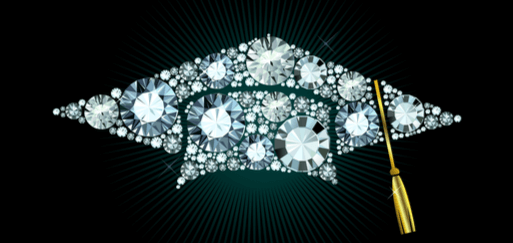What are the words that come to mind when you think of diamonds?
Sparkle, romance, engagement, Marilyn Monroe, Tiffany, forever...
But there's much more to diamonds than weddings and pop culture. Diamonds are a wearable gemstone with a long history. From ancient times till today, myths abound about the power and value of diamonds. Of course, they are steeped in history and drama too, such as the Curse of the Hope Diamond or the Koh-i-Noor diamond that has changed hands numerous times through theft and confiscation. Not to mention the connections to the rich and famous, and to modern royalty. Sometimes, it's good to go beyond the 4Cs and get a deeper understanding of diamonds. What are the top 10 diamond facts every diamond shopper must know? Here they are (and a bonus fact at the end!):
- The word diamond derives from the Greek word “adamas,” which means invincible or indestructible. In ancient times, diamonds were believed to promote strength, invincibility and courage. The ancient Greeks believed that diamonds were splinters of stars that fell to earth. Romans maintained that diamonds had the power to ward off evil and wore them as talismans. They inherited this belief from Indian mythology.
- The Earth is estimated to be 4.5 billion years old. Most diamonds found in nature are between one to three billion years old, with the oldest thought to have crystallized 3.3 billion years ago.
- The diamond is the hardest natural substance found on the Earth. They have an extremely high melting point of 3820K (3547' C/ 6420' F), and a diamond’s boiling point is 5100K (4827' C/ 8720' F). To uncover a single one-carat diamond, 250 tons of earth will be mined. Diamond crystals are brought closer to the earth’s surface through volcanic activity. Recently, scientists discovered there is a quadrillion tons of diamonds 100 miles beneath the earth's surface.
- The earliest record of a man proposing with a diamond ring was in 1477 when Archduke Maximilian of Austria presented Mary of Burgundy with a diamond ring while asking for her hand in marriage.
- According to Statista, although the U.S. produces a negligible amount of the total global gemstone production, in 2016 Americans bought nearly 50% the world's total volume of gem quality diamonds.
- The largest diamond ever discovered was the Cullinan at a whopping 3,106 carats!
- Back in the thirteenth-century, a law was passed in France allowing only the King to wear diamonds.
- Diamonds are colorless in their pure state. Colored diamonds get their hue from interstitial impurities. The rarest colored diamonds are red and blue and the most common colored diamonds are yellow and brown.
- The word carat comes from the word 'keration', the Mediterranean carob tree whose seed was used for centuries as the standard of weighing precious stones.
- Diamonds are primarily used in jewelry, but did you know they were also used to polish weapons? Scientists discovered that over 4,500 years ago the ancient Chinese would make their ceremonial burial axes out of ruby and sapphire polished them with diamonds to give them nice shiny finish.
Bonus Fact!
Although the hardest substance on earth, diamonds have been cut and produced with the use of advanced technologies only in the past 30 or so years. Computerization has enabled much more sophisticated diamond processing, from rough planning and inclusion mapping, to automated cut grading, green laser sawing, and most recently, the adoption of artificial intelligence. Although technology is a relative newcomer to the long history of the diamond industry, it has been the driving force behind ever more sophisticated, accurate diamond production, which has led to even more beautiful diamonds.




-1.jpg?width=310&name=blog_image%20(003)-1.jpg)





